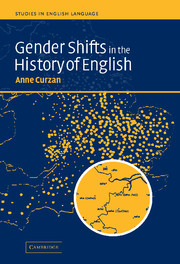Book contents
- Frontmatter
- Contents
- Acknowledgments
- Introduction
- 1 Defining English gender
- 2 The gender shift in histories of English
- 3 A history of gender, people, and pronouns: the story of generic he
- 4 Third-person pronouns in the gender shift: why is that ship a she?
- 5 Gender and asymmetrical word histories: when boys could be girls
- 6 Implications for nonsexist language reform
- Appendix 1 Background on early English personal pronouns
- Appendix 2 Helsinki Corpus texts and methodology
- References
- Index
Appendix 1 - Background on early English personal pronouns
Published online by Cambridge University Press: 22 September 2009
- Frontmatter
- Contents
- Acknowledgments
- Introduction
- 1 Defining English gender
- 2 The gender shift in histories of English
- 3 A history of gender, people, and pronouns: the story of generic he
- 4 Third-person pronouns in the gender shift: why is that ship a she?
- 5 Gender and asymmetrical word histories: when boys could be girls
- 6 Implications for nonsexist language reform
- Appendix 1 Background on early English personal pronouns
- Appendix 2 Helsinki Corpus texts and methodology
- References
- Index
Summary
This brief survey of some of the early linguistic developments in English personal pronouns is designed to provide useful background for the studies of the early English gender system and the gender shift described in Chapters Three and Four, as some forms of the third-person pronouns in Old and Middle English will look unfamiliar to Modern English speakers. In the process, this appendix explains linguistic curiosities such as the coexistence of sh- and h- forms for the feminine personal pronouns and the dialectal use of “'em” in the plural.
Although by late Middle English, the language had lost most inflectional case endings on nouns, adjectives, and articles as well as grammatical gender, it preserved case and gender distinctions in the personal pronouns. In fact, Middle English not only preserved the distinctions from Old English, it also adopted new more distinctive pronominal forms: they and she. The distinct Old English third-person pronouns he (masculine), heo (feminine), and hie (plural) seem to have been merging in many Middle English dialects, at least in the written form, into a form often written he, about the time when the northern and midland dialects adopted the new pronominal forms they and she, which helped to preserve distinctions of number and gender in the personal pronouns.
- Type
- Chapter
- Information
- Gender Shifts in the History of English , pp. 189 - 194Publisher: Cambridge University PressPrint publication year: 2003

